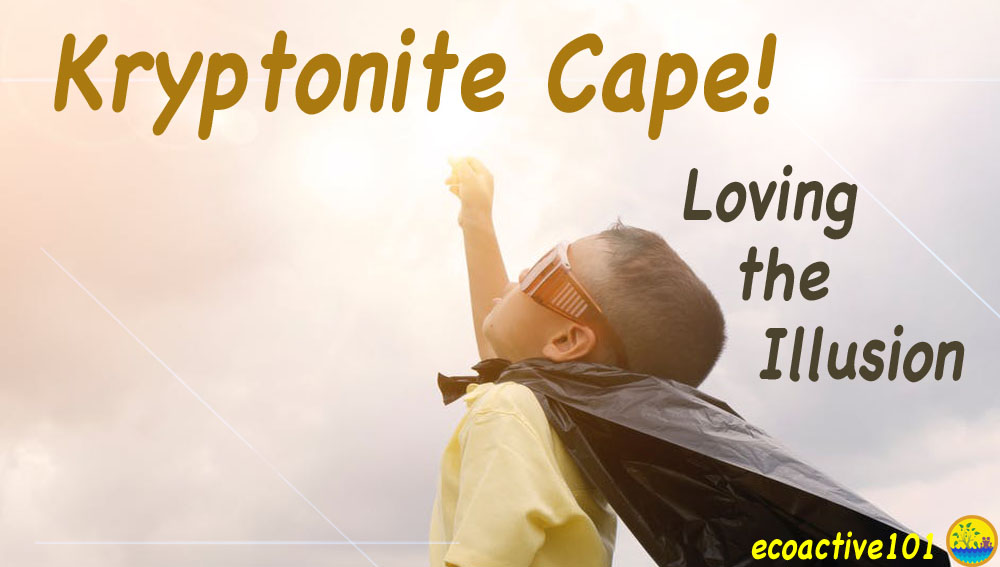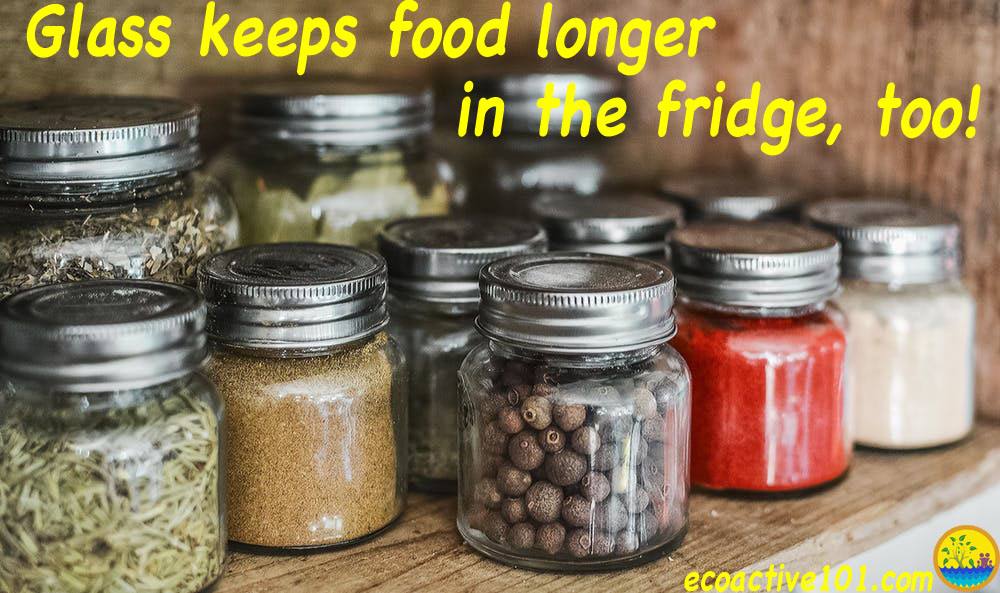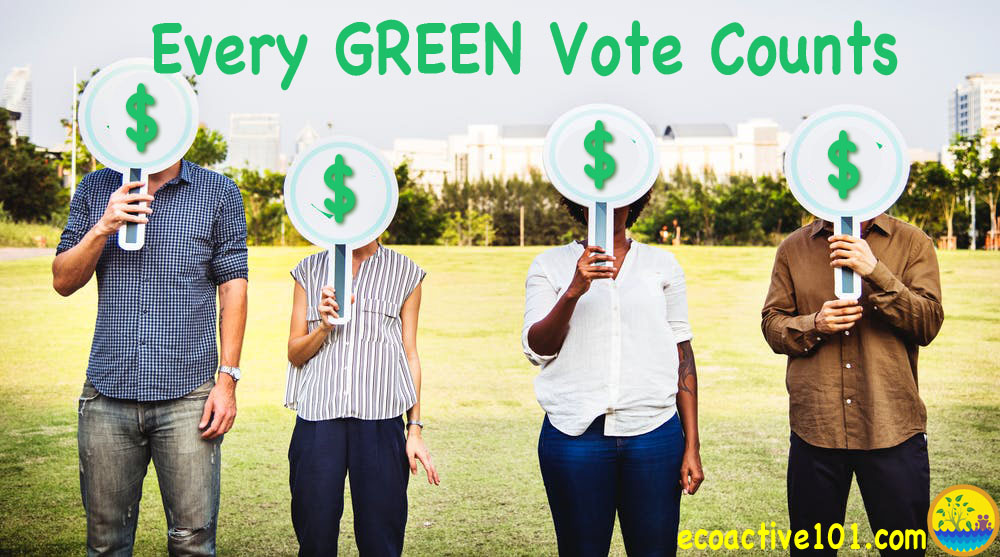Plastic can be fun—plastic Hallowe’en capes, masks, goggles and ears and tails. Plastic Christmas trees. Plastic squeaky pet toys. Squirt guns. Sunglasses.

Trouble is, it’s everywhere.
Have you noticed? Take a look around your home or office. Does your eye land on plastic water bottles? Plastic cups, plates, forks and spoons, drinking straws? Ziplock and other sandwich, freezer and trash bags? Plastic CDs and DVDs?
Worst of all is that horrid plastic shrink-wrap packaging you have to cut open. Runner-up: the plastic clamshell containers most berries are now sold in, even at many farmer’s markets.
Magazines, even! I used to read Conde Nast’s Wired magazine. I liked it fine, until the replaced the glossy paper cover with a plasticized one. Why does a magazine need a plastic cover? Not only that, they delivered it sealed in plastic so tough I had to use scissors to get the magazine out of its wrapper.
I canceled my subscription.

What’s Wrong with Plastic?
For ecological reasons, I’m doing my best to get single-use plastics out of my life. The manufacture of plastics not only contributes to pollution, it also adds to the carbon footprint and the greenhouse layer that have become the focus of the global fight for a sustainable earth.
Then there’s the source material problem: traditionally, plastics are made from petroleum, a non-renewable, primarily Middle-Eastern resource that costs us soldiers’ lives and hundreds of billions in military dollars each year and leads to millions of civilian deaths in the lands we occupy. The alternative is American oil, which means drilling more life-endangering oil wells here.
Also, plastic has a deleterious impact on our health. I recently read a Reader’s Digest article enumerating the many health problems caused by exposure to plastics. I learned that it’s not just to the BPA in plastics, that the BPA replacements we feel so safe with now appear to produce a broad range of of undesirable health effects similar to those produced by exposure to BPA, contributing to birth defects, miscarriages, obesity, diabetes, heart disease and high blood pressure. They also cause bowel irritation and genital birth defects, affect thyroid and other endocrine functions, and more.
What about the new bioplastics? Plant-based plastics have a lower carbon footprint, in that as they degrade they simply release the carbon that was sucked up by the plants from which they’re created (as opposed to releasing carbon that was trapped in oil deposits)—a major consideration when we’re thinking climate change.
And since they require no mining, their processing is significantly less destructive than that of petroleum-based plastics. On the other hand, bioplastics are often produced from trees that would not otherwise have been cut down. Even if made from bamboo, hemp, or some other plant, there is a cost to the water and soil additives used to grow the plants from which the plastic is produced (though hemp doesn’t take much water and is probably the best choice). And depending on what chemicals were used in their production, they may or may not be toxic. Finally, even plastic from biomass ends up as trash, contributing to unecological landfill or perhaps harming or killing wildlife.

Dining Out and Grocery Shopping
When I dine out, I often ask for a doggie bag. Many restaurants are taking steps to eliminate petroleum-based plastics. What most don’t realize is that bioplastics are still plastics, still a threat to wildlife on our beaches, and they only biodegrade in industrial composting plants, which few will end up in.
So, while plant-based plastics are more ecologically sound than their petroleum-derived counterparts, they’re not an ideal solution. What to do? Three suggestions:
- Make a point of speaking to the restaurant manager about replacing plastic containers with containers made from heavy paper, or
- Consider taking your own reusable containers to hold your takeaway food. You can carry them in an attractive canvas bag, and if you don’t need them, no harm done.
- Do both of the above—take your own containers AND talk to the manager.
When you go shopping, do you bring home plastic grocery or produce bags? I used to. Conscious shoppers learn to take their own reusable canvas bags, but it took me a while to start remembering to take them into the store with me. No matter. You can say no to the store’s paper or plastic bags, stack your purchases in the cart, wheel it out to your car and transfer them to your own canvas bags for easy carrying into the house when you get home.
When buying fresh produce, there’s no harm in skipping the bag altogether. I used to like getting those plastic produce bags so I could reuse them as liners for my countertop compost bin. No more! Who needs a liner? A quick rinse after I empty the container and I’m good to go.
Multi-Use But Still Disposable
And then, if you’re like me, there are the multi-use but still landfill- or recycle-bound product containers on your kitchen shelves—plastic oil bottles, plastic soy sauce and vinegar bottles, plastic spice jars, plastic nut butter containers, and so on. Products we used to buy in glass!
What makes glass better? First, it’s made from plentiful materials that are available right here. Second, glass doesn’t contain toxins that endanger your health. Third, it doesn’t threaten sea life. True, it’s not ideal—it’s heavy and has a bigger transportation footprint than plastic, making it hard to get to recycling plants. But I reuse the Ball and Mason jars I buy food in for storing leftovers in the refrigerator. I’ve found they keep food fresher than plastic.

Now it’s time to sneak a look under the sink. What do you see? In my case, a slew of plastic household cleaner containers greets my jaundiced eye.
And in the bathroom? Plastic toothpaste tubes? Plastic combs and brushes? Plastic shower cap? Shower curtain liner? Eventually, these will all hit the trash or the recycle pile, and most will end up in landfill.
Recycling Has Become Less Available
It used to be I didn’t feel so bad about plastics because we could recycle them. But not all plastics are recyclable, and it’s hard to know the difference between those that are and those that aren’t.
And now that China has stopped accepting imports of mixed paper and severely cut back on plastic recycling, most of our single-use plastics—even the ones you dutifully wash and put in the recycle bins—are likely destined for landfill. And some American cities, counties and states no longer support plastic recycling; in some cases, recycling is entirely a thing of the past.
It’s Up to Us—Vote with Your Dollars!
Vote with your dollars, and let manufacturers know. As the saying goes, the pen—or the computer—is mightier than the sword. I’ve started writing to let them know that plastic packaging is the reason I’m no longer buying their products. It’s not hard—I designate half an hour a week to visiting the websites of brands whose products I no longer buy or buy less of because they’re packaged in plastic.
Most either publish an email address or a contact form; I click “Contact” at the top of the site or scroll down to the footer at the bottom of the page and click “Contact” there. Then I paste in this note, brief and to-the-point:
“I’ve been a customer of yours for years, but I am no longer buying your products because of your plastic packaging. When you start making them available in more ecologically sound packaging, I will consider buying them again.”

Does changing your buying habits change your lifestyle? Sure, to a certain extent. When I can find brands that use more eco-friendly packaging (glass, cardboard, celophane or waxed heavy card stock), I switch. If I can’t find one—for example, it seems all cottage cheese and sour cream is now packaged in plastic—I often experiment with a reasonable homemade facsimile.
My homemade cashew-nut vegan cream cheese, I admit, doesn’t taste like cream cheese. But it’s great mixed with fresh mango, a dessert I would never have discovered had I not decided to stop buying vegan cream cheese in plastic containers. (And since I’m not 100% vegan I bought dairy cream cheese today, packaged in foil and paper.)
Am I saying I never buy anything packaged in plastic anymore? No, I’m not there yet, but I’m moving in that direction. I slipped today and bought blueberries in plastic, didn’t think about it until I put my groceries away. It happens.
But as more of us look for alternatives to plastic-packaged goods and let manufacturers know we’re serious about getting single-use plastics out of our lives, they will have no choice but to respond.
I had no idea how plastic-riddled my life has become until I decided to phase out single-use plastics.
Change Isn’t Easy, But It Beats Extinction
Please don’t misunderstand—I’m not saying change is easy. Change can be a real challenge. But change we must. And it does open new doors to discovery.
Sure, you’re only one person. Your actions alone are not going to save the planet. But every meaningful change starts with one person, joined by another, and another and another … and voilà, the change that seemed hard becomes a trend.
And when we all speak out to let providers know you’re voting with our dollars, they will respond. Yes, it’s the corporations that need to change. But it’s we who must force them to to do that.
The ball is in your court. Care to pick it up and play? Our survival depends on the actions we take.
To your eco-active empowerment,
Chiwah
Eco Activist 🙂 Kids’ Book Author 💡 Editor 😯 Book Formatter 😎 Cover Designer 😀 Publisher
AWriteToKnow.com, PetWrites.com
Email: Info@EcoActive101.com

